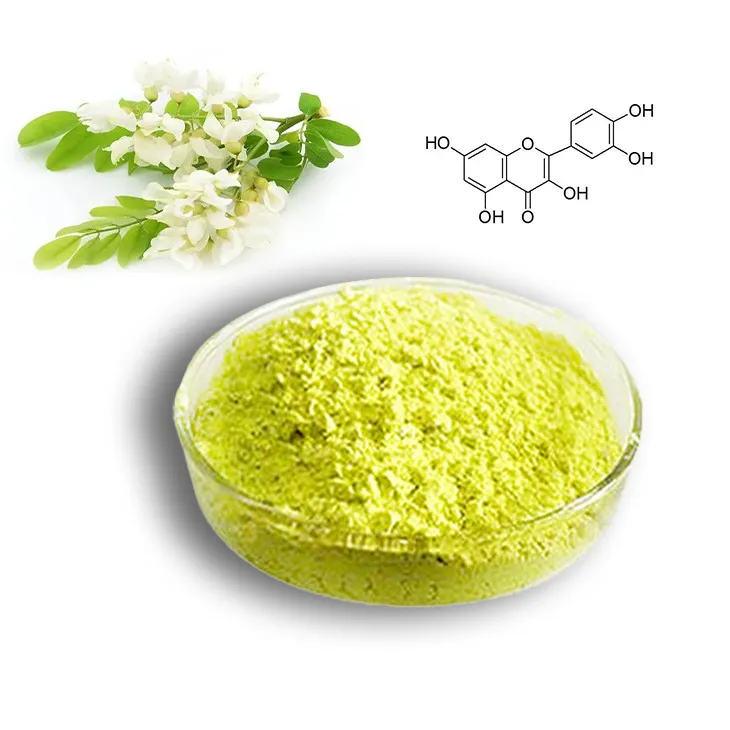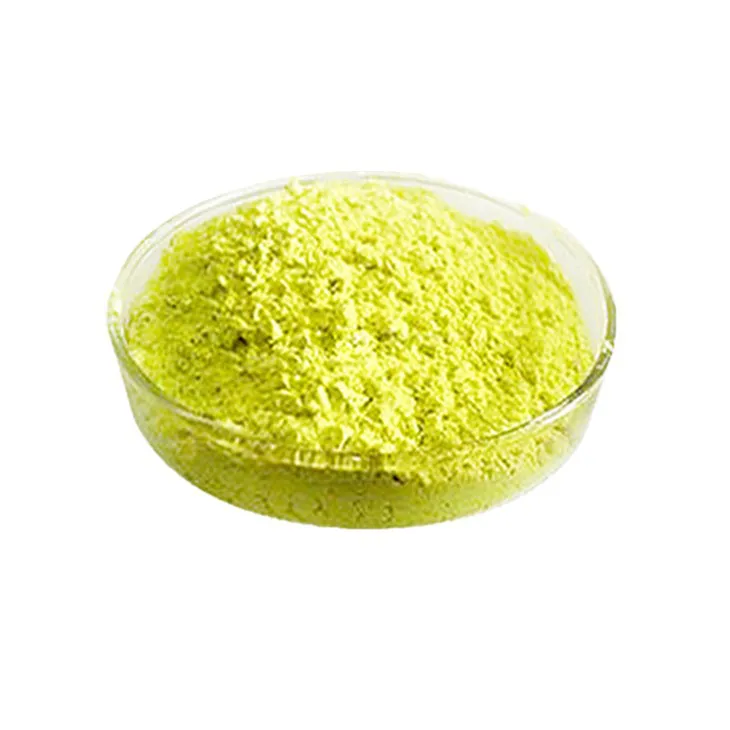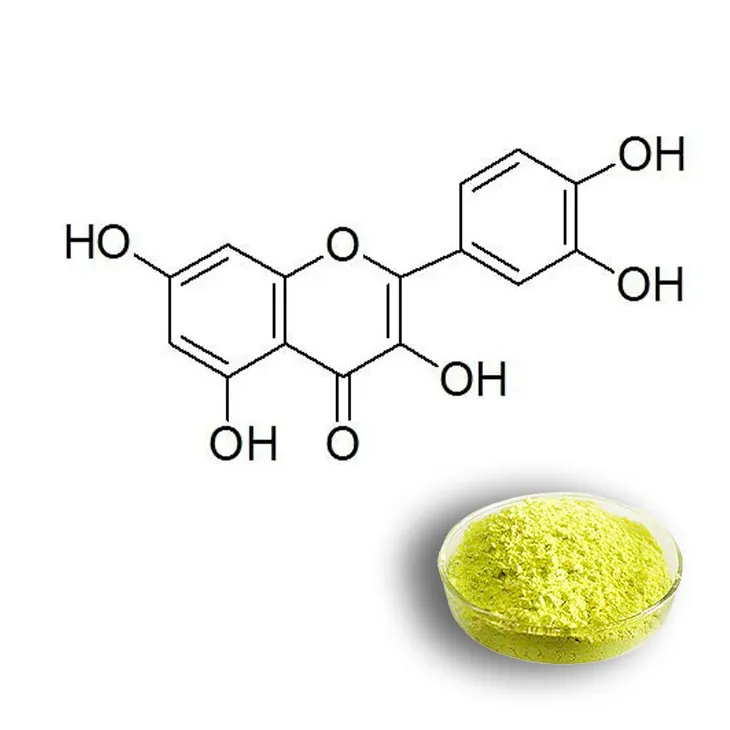- 0086-571-85302990
- sales@greenskybio.com
How to Extract Quercetin from Plants?
2024-11-28

1. Introduction
Quercetin is a flavonoid compound that has attracted significant attention in various fields, including antioxidant research, pharmaceutical development, and food science. Many plants are natural sources of Quercetin, and extracting it from these plants is a complex yet fascinating process. In this article, we will explore the different methods and considerations involved in the extraction of Quercetin from plants.

2. Plant Sources of Quercetin
Buckwheat is one of the well - known plant sources of quercetin. It contains a relatively high amount of this flavonoid. Other plants such as onions, apples, and tea also contain quercetin, although in varying concentrations. The choice of plant source can significantly influence the extraction process and the yield of quercetin.

3. Pre - treatment of Plant Materials
3.1 Drying
Drying is an essential step in the pre - treatment of plant materials for quercetin extraction. It helps to reduce the moisture content of the plants, which can prevent the growth of microorganisms during the extraction process. There are different drying methods available, such as air drying, oven drying, and freeze - drying. Air drying is a simple and cost - effective method, but it may take a longer time. Oven drying can be faster, but it requires careful control of the temperature to avoid over - heating the plant materials, which could potentially degrade the quercetin. Freeze - drying is a more advanced method that can preserve the structure and chemical composition of the plant materials better, but it is also more expensive.
3.2 Grinding
After drying, the plant materials are usually ground into a fine powder. Grinding increases the surface area of the plant materials, which enhances the contact between the plant matrix and the extraction solvent. This results in a more efficient extraction process. The grinding can be done using a mortar and pestle for small - scale extractions or a mechanical grinder for larger - scale operations.

4. Maceration Extraction
Maceration extraction is a traditional method for extracting quercetin from plants. In this method, the pre - treated plant materials are soaked in a solvent for a long time. The solvent penetrates the plant matrix and dissolves the quercetin. Commonly used solvents for maceration extraction include ethanol, methanol, and water.
4.1 Solvent Selection
The choice of solvent is crucial in maceration extraction. Ethanol is a popular solvent as it has a good solubility for quercetin and is relatively safe and easy to handle. Methanol can also be used, but it is more toxic and requires more careful handling. Water is a less effective solvent for quercetin on its own, but it can be used in combination with organic solvents to improve the extraction efficiency. For example, a mixture of ethanol and water can be used to adjust the polarity of the solvent system according to the characteristics of the plant materials.
4.2 Extraction Time and Temperature
The extraction time and temperature also play important roles in maceration extraction. Longer extraction times generally result in higher yields of quercetin, but there is a limit beyond which further extraction may not be significant. The extraction temperature should be carefully controlled. Higher temperatures can increase the solubility of quercetin in the solvent, but they may also cause the degradation of quercetin or other components in the plant materials. A typical extraction temperature range is between 20 - 50°C.

5. Supercritical Fluid Extraction
Supercritical fluid extraction (SFE) using carbon dioxide (CO₂) is a more advanced and cleaner method for quercetin extraction. CO₂ in its supercritical state has unique properties that make it an excellent solvent for extracting natural products.
5.1 Principles of Supercritical Fluid Extraction
When CO₂ is in its supercritical state (above its critical temperature and pressure), it has the density of a liquid and the diffusivity of a gas. This allows it to penetrate the plant matrix easily and dissolve the quercetin. By adjusting the pressure and temperature, the solubility of quercetin in supercritical CO₂ can be controlled. After the extraction, the CO₂ can be easily removed by reducing the pressure, leaving behind the extracted quercetin without any solvent residues.
5.2 Advantages of Supercritical Fluid Extraction
There are several advantages of using SFE for quercetin extraction. Firstly, it is a clean method as CO₂ is non - toxic, non - flammable, and environmentally friendly. Secondly, it can provide a high - purity product as there are no solvent residues. Thirdly, it can be more selective in extracting quercetin compared to traditional solvent extraction methods, which can reduce the extraction of unwanted components from the plant materials.
6. Post - extraction Processing
After the extraction of quercetin, the extract usually needs to be further processed. This may include filtration to remove any solid particles, concentration to increase the quercetin content, and purification to remove any impurities.
6.1 Filtration
Filtration is the first step in post - extraction processing. It can be done using a filter paper, a membrane filter, or a filter press, depending on the scale of the extraction. Filtration helps to remove any plant debris, undissolved solids, or other impurities from the extract.
6.2 Concentration
Concentration is often necessary to increase the quercetin content in the extract. This can be achieved by methods such as evaporation under reduced pressure or by using a rotary evaporator. However, care should be taken during the concentration process to avoid the degradation of quercetin due to over - heating.
6.3 Purification
Purification is the final step in post - extraction processing. It can be done using chromatography techniques such as column chromatography, high - performance liquid chromatography (HPLC), or solid - phase extraction (SPE). These techniques can separate quercetin from other components in the extract and provide a highly purified quercetin product.
7. Applications of Extracted Quercetin
The extracted quercetin has a wide range of applications in different fields.
7.1 Antioxidant Research
Quercetin is a powerful antioxidant. It can scavenge free radicals and protect cells from oxidative damage. In antioxidant research, quercetin is often used as a model compound to study the mechanisms of antioxidant action. It can also be incorporated into food products or dietary supplements to provide antioxidant benefits.
7.2 Pharmaceutical Development
Quercetin has shown potential in pharmaceutical development. It has anti - inflammatory, anti - cancer, and anti - microbial properties. Research is ongoing to develop quercetin - based drugs or to use quercetin as an adjuvant in existing drug therapies.
7.3 Food Science
In food science, quercetin can be used as a natural food additive. It can improve the shelf - life of food products by preventing oxidation. It can also be added to functional foods to enhance their nutritional value.
8. Conclusion
Extracting quercetin from plants is a multi - step process that involves pre - treatment of plant materials, extraction using methods such as maceration or supercritical fluid extraction, and post - extraction processing. The choice of plant source, extraction method, and post - extraction processing steps can significantly affect the yield and quality of the extracted quercetin. With the increasing demand for natural products with health - promoting properties, the extraction of quercetin from plants is likely to continue to be an area of active research and development.
FAQ:
What are the common plants containing quercetin?
One of the common plants known to contain quercetin is buckwheat. There are also other plants that may contain quercetin, but buckwheat is a well - known source.
Why is pre - treatment of plant materials important in quercetin extraction?
Pre - treatment such as drying and grinding is important in quercetin extraction. Drying helps to reduce the moisture content which can affect the extraction process. Grinding breaks down the plant material into smaller particles, increasing the surface area. This allows for better contact with the extraction solvent, which in turn can enhance the efficiency of quercetin extraction.
What is maceration extraction?
Maceration extraction is a traditional method in which the plant material is soaked in a solvent for a long time. This long - term soaking allows the solvent to penetrate the plant cells and dissolve the quercetin, which can then be separated from the plant material.
What are the advantages of supercritical fluid extraction using carbon dioxide in quercetin extraction?
Supercritical fluid extraction using carbon dioxide has several advantages. It offers a cleaner method as carbon dioxide is a non - toxic and environmentally friendly solvent. It can also be more efficient as it can selectively extract quercetin with high purity. Moreover, it can operate at relatively mild conditions, which helps to preserve the properties of the extracted quercetin.
What are the applications of extracted quercetin?
The extracted quercetin can be used in various areas. In antioxidant research, it is studied for its antioxidant properties which can help in preventing oxidative damage. In pharmaceutical development, it has potential uses such as in the development of drugs for various diseases, as it may have anti - inflammatory and other beneficial biological activities.
Related literature
- Quercetin: A Promising Natural Compound with Multiple Health - Beneficial Properties"
- "Extraction Techniques for Quercetin from Plant Sources: A Review"
- "The Role of Quercetin in Antioxidant and Pharmaceutical Applications: Current State of Research"
- ▶ Hesperidin
- ▶ Citrus Bioflavonoids
- ▶ Plant Extract
- ▶ lycopene
- ▶ Diosmin
- ▶ Grape seed extract
- ▶ Sea buckthorn Juice Powder
- ▶ Fruit Juice Powder
- ▶ Hops Extract
- ▶ Artichoke Extract
- ▶ Mushroom extract
- ▶ Astaxanthin
- ▶ Green Tea Extract
- ▶ Curcumin
- ▶ Horse Chestnut Extract
- ▶ Other Product
- ▶ Boswellia Serrata Extract
- ▶ Resveratrol
- ▶ Marigold Extract
- ▶ Grape Leaf Extract
- ▶ New Product
- ▶ Aminolevulinic acid
- ▶ Cranberry Extract
- ▶ Red Yeast Rice
- ▶ Red Wine Extract
-
Marigold Extract
2024-11-28
-
Black Pepper Extract
2024-11-28
-
Mango flavored powder
2024-11-28
-
Cranberry Extract
2024-11-28
-
Black Garlic Extract
2024-11-28
-
Shikonin
2024-11-28
-
Buckthorn bark extract
2024-11-28
-
Peppermint Oil
2024-11-28
-
Wheat Germ Extract
2024-11-28
-
Moringa powder
2024-11-28





















